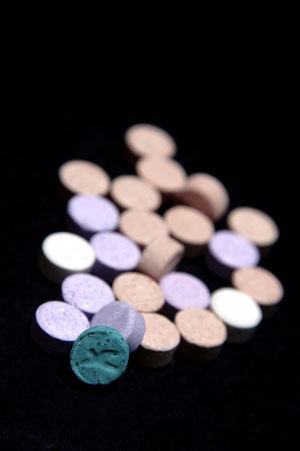1 888-488-8434
Referral Service
Private Treatment Centers
in Canada
Molly, E, or MDMA are other names, to name a few, for what is better known as ecstasy. MDMA is an abbreviation for 3,4-methylenedioxymethamphetamine, its scientific name. Known as a party drug, people take ecstasy in pill form or powder. Pills come in different colours and design logos. It is a man-made drug that gained popularity in the 1980s. It has similarities to amphetamine (alpha-methylphenethylamine) and mescaline (3,4,5-trimethoxyphenethylamine.)

1 888-488-8434
Toll-free Number

Its effects include a sense of well-being and extroversion. It also increases an individual’s feeling of empathy and compassion towards others. As a distinguishing characteristic, MDMA enhances sensory perception. When taken in pill form, the effects begin in 30 to 45 minutes and can last 3 to 6 hours.
Adam, X, XTC, Beans, Candy, E-bomb, Thizz, Love Drug, Rolls, Skittles, Sweets, Vitamin E or X.
Combined with Alcohol, MDMA decreases alcohol’s effects. Alcohol can increase plasma concentrations of MDMA, which may increase the risk of neurotoxic effects.
You might experience these symptoms days after taking MDMA:
Some will want to avoid the unpleasant “comedown” sensation by using more ecstasy or using other drugs such as alcohol, benzos, or cannabis. This practice only elevates the risk of addiction to MDMA and other drugs taken. Ecstasy can create a psychological dependency and tolerance in many individuals.
Elevated levels of serotonin are responsible for the feelings a person experiences with this drug. This key hormone plays a vital role in the following:
Ecstasy can produce serotonin syndrome in heavy users or people on certain medications. (For more information, see link below)
Serotonin syndrome can cause various symptoms:
Diarrhea, shivering, rigidity in the muscles, dilated pupils, lessened motor control, increased heart rate, high blood pressure, seizures, and loss of consciousness
Regular use of MDMA may cause:
Several reports show that cognitive deficiency, learning and memory problems can come from long-term MDMA or heavy usage.
Stopping MDMA after a long-time usage is problematic. As with any drug withdrawal, the body has to get used to functioning without its presence. Symptoms should diminish after a week and will mostly disappear after a month. Here are the symptoms:
Using Ecstasy can lead to various problems:
Ecstasy has a high potential for misuse and addiction. People wanting to stop should do so with the help of a professional treatment program. If you need assistance finding a private MDMA rehab, call our toll-free number or request a callback.